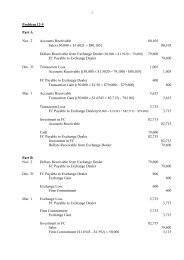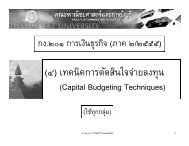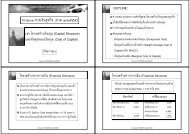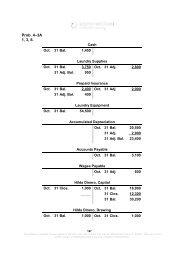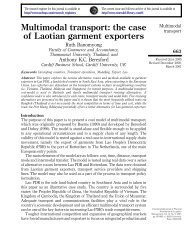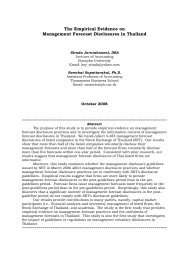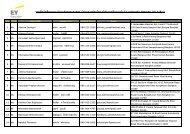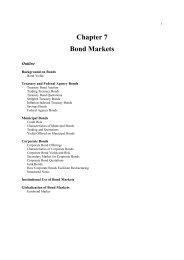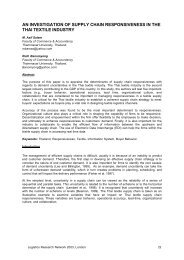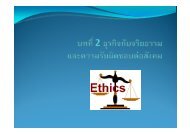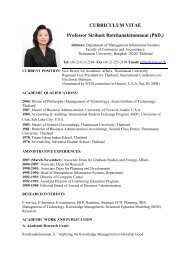Human capital and performance: A literature review
Human capital and performance: A literature review
Human capital and performance: A literature review
You also want an ePaper? Increase the reach of your titles
YUMPU automatically turns print PDFs into web optimized ePapers that Google loves.
Annotated Bibliography<br />
<strong>Human</strong> Capital Management – A Frame of Reference<br />
Bontis, N. & Fitz-enz, J. (2002). Intellectual <strong>capital</strong> ROI: a causal map of human <strong>capital</strong><br />
antecedents <strong>and</strong> consequents. Journal of Intellectual Capital, 3 (3), pp. 223-247.<br />
The authors report the results of a research study that examine the antecedents <strong>and</strong> consequents of<br />
effective human <strong>capital</strong> management through the integration of the quantitative <strong>and</strong> qualitative<br />
measures. The research sample consisted of 76 senior executives from 25 companies in the financial<br />
services industry. A holistic causal map is yielded on the ground of the integrated constructs from the<br />
fields of intellectual <strong>capital</strong>, knowledge management, human resources, organizational behavior,<br />
information technology <strong>and</strong> accounting. Participating organizations <strong>and</strong> researchers can reap the<br />
benefits of the study through visually comprehending the driving factors that determine the<br />
effectiveness of an organization’s human <strong>capital</strong> capabilities. Practitioners <strong>and</strong> researchers will have<br />
a better underst<strong>and</strong>ing in allocating resources with regard to human <strong>capital</strong> management more<br />
efficiently. The potential outcomes of the study are limitless, since a program of consistent reevaluation<br />
can lead to the establishment of causal relationships between human <strong>capital</strong> management<br />
<strong>and</strong> economic <strong>and</strong> business results.<br />
Brown, M. G. (1999). <strong>Human</strong> <strong>capital</strong>’s measure for measure. Journal for Quality & Participation,<br />
22 (5) September/October, pp. 28-31.<br />
The author points out some problems of the HR metrics on the value <strong>and</strong> <strong>performance</strong> of the human<br />
asset. The crude measure factors include turnover, education level, training attended, <strong>and</strong><br />
development plan objectives. He therefore suggests 4 sub-metrics for creating a human <strong>capital</strong> index,<br />
namely number of years in business/field, level in the company (by job grade or organizational chart<br />
level), <strong>performance</strong> rating, <strong>and</strong> number <strong>and</strong> variety of positions/assignments held. Nevertheless, it<br />
seems to raise the issue of subjectivity in determining the weights/scores to be marked on each<br />
category, leading to a relative imbalance of the human <strong>capital</strong> index used to justify the human asset in<br />
a particular firm <strong>and</strong> industry.<br />
Combs, J. G. & Skill, M. S. (2003). Managerialist <strong>and</strong> human <strong>capital</strong> explanations for key<br />
executive pay premiums: a contingency perspective. Academy of Management Journal, 46 (1), pp.<br />
63-73.<br />
This study examines a contingency perspective in which the source of pay premiums depends on<br />
executives’ power <strong>and</strong> firms’ governance strength. Two main theories, which are managerialism <strong>and</strong><br />
human <strong>capital</strong>, are drawn to investigate the executive-specific attributes (power <strong>and</strong> skill) so as to<br />
explain variation beyond what firm- <strong>and</strong> job-specific variables are predicted. Results suggest pay<br />
premiums are a consequence of human <strong>capital</strong> (compensation for unique <strong>and</strong> valuable managerial<br />
competencies) in some firms <strong>and</strong> managerial entrenchment (executives using their power to maximize<br />
salary) in others.<br />
Crutchfiled, E. B. (2000). Developing human <strong>capital</strong> in American manufacturing: a case study of<br />
barriers to training <strong>and</strong> development. New York: Garl<strong>and</strong> Publishing.<br />
This book reflects a practical research of a case study approach on the development of human <strong>capital</strong><br />
through the firm’s training programs. An exhaustive stream of <strong>literature</strong> <strong>review</strong> examines a broad<br />
range of themes <strong>and</strong> theories on the dynamically competitive environment facing the American<br />
workforce at the expense of attempting to maintain a competitive edge. Also, the concepts of human<br />
resource development <strong>and</strong> organization development present the theoretical ‘best practices’ for how<br />
organizations should be working to develop their human asset <strong>and</strong> become a high performing<br />
<strong>Human</strong> <strong>capital</strong> <strong>and</strong> <strong>performance</strong> 29



